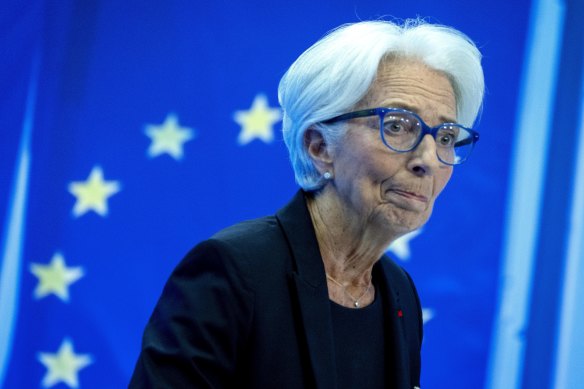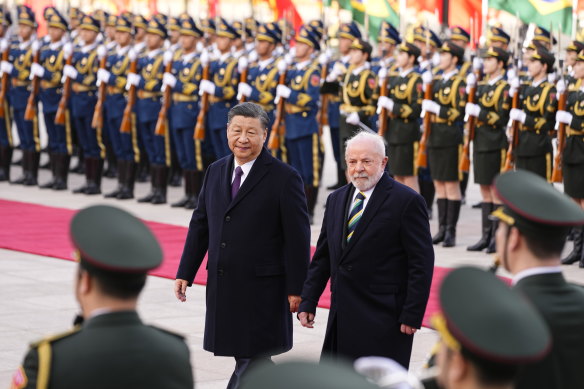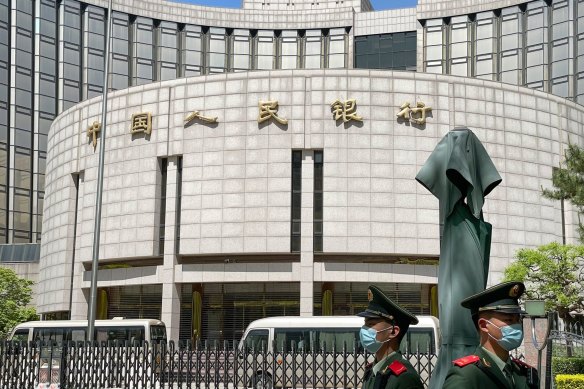Save articles for later
Add articles to your saved list and come back to them any time.
Singapore: First, there was oil in Saudi Arabia, then there was nuclear power in Bangladesh and, finally, there were railways in Pakistan. China is taking multibillion-dollar transactions away from the international currency that has underpinned them for generations, the US dollar, and pushing them into the yuan.
On Thursday, Argentina announced that it would pay for all Chinese imports in yuan instead of US dollars. It followed Brazil days earlier which said it would drop the US dollar as its intermediary currency for transactions with China.
Beijing is offering the yuan as a global trading currency to the US dollar.Credit: Getty
Last week, Bangladesh paid the equivalent of $481 million to a Russian nuclear power developer in yuan to avoid Western sanctions over the war in Ukraine.
Beijing, which has courted headlines over its vision for a fairer global order, its denouncement of US hegemony and restrictions imposed on developing countries by the West, is increasingly tying its diplomatic endeavours to an alternative financial model that is attempting to wean global players off their reliance on the greenback.
European Central Bank President Christine Lagarde said last week the developments do not point to any imminent loss of dominance for the US dollar or the euro.
“But they do suggest that international currency status should no longer be taken for granted,” she said.
Christine Lagarde, president of the European Central Bank.Credit: AP
For most of the past century, the US dollar turned central banks into what economist John Maynard Keynes described as the “conductor of the international orchestra”.
Its centrality meant that, to trade, governments had to navigate international standards or be exposed to sanctions. Now that is under threat.
“All this could create an opportunity for certain countries seeking to reduce their dependency on Western payment systems and currency frameworks – be that for reasons of political preference, financial dependencies, or because of the use of financial sanctions in the past decade,” Lagarde said.
In March, China brought Saudi Arabia and Iran together over the conflict in Yemen. By the end of the month, Saudi Arabia was in discussions about pricing its oil sales in yuan. Iran’s Ministry of Economic Affairs said it would use yuan, also known as renminbi (RMB), wherever possible in bilateral trade.
Brazilian President Luiz Inacio Lula da Silva and Chinese President Xi Jinping. Credit: Getty
China tried this before between 2011 and 2015 and failed. But it now has three major factors in its favour: new digital payment systems that allow for large encrypted payments to be made without using the US-backed SWIFT system, deepening geopolitical splits, and frustrations over the rising cost of the US dollar in developing countries hit hard by COVID-19 and the war in Ukraine.
Now there is talk among its economic partners of an Asian Monetary Fund to discourage the region from using the US dollar altogether, opening the door to two monetary blocs, two global currencies and two payment systems.
“There is no reason why countries like Malaysia continue to rely on the dollar,” Prime Minister Anwar Ibrahim told the Malaysian parliament this month after returning from a meeting with Chinese President Xi Jinping in Beijing.
This macro-level shift could have significant consequences for the competitiveness of smaller nations and whether they can trade in their own currencies. But it could hit the lives of ordinary citizens by allowing some states to dodge sanctions, reducing their accountability over human rights abuses and unjustified military action.
The People’s Bank of China building in Beijing. The Chinese currency is making inroads into global trade.Credit: Bloomberg
“There is a risk when we use financial sanctions that are linked to the role of the dollar that over time it could undermine the hegemony of the dollar,” US Treasury Secretary Janet Yellen said last week. “Of course, it does create a desire on the part of China, of Russia, of Iran, to find an alternative.”
China’s campaign is largely targeting its major economic partners for now because it has enough leverage as a major supplier to ask for payment in its own currency. In March, the Shanghai Petroleum and Natural Gas Exchange said China had imported liquefied natural gas from the United Arab Emirates using yuan for the first time.
This month, Ahsan Iqbal, Pakistan’s minister of planning, said it was structuring a $14 billion deal to build one of its major railways using the Chinese currency. Russian Deputy Prime Minister Alexander Novak said last week Moscow intended to abandon the US dollar for all energy transactions in favour of local currencies.
“If you are a heavy trading partner with China, it makes sense,” said Dr Lurion De Mello from Macquarie Business School.
“If countries can develop alternative pathways and still maintain trade and interbank transfers, then sanctions are going to have minimal impact.”
But the campaign is also reaching a wider audience sympathetic to what it sees as an over-dominance of the American financial system. They are worried it could put other economies at risk if there is a conflict between China and Taiwan in the coming decade.
French President Emmanuel Macron returned to Paris from Beijing in April suggesting that Europe should reduce its dependence on the “extraterritoriality of the US dollar”. The statement was as part of a wider interview that was criticised by Washington and other European leaders.
For now, the language that surrounds Beijing’s yuan campaign is more interesting than the actual cash flows, which remain a fraction of US volumes, mostly because of the dominance of Western sharemarkets which use the greenback for international transactions.
“When we’re looking at global trade financing, it’s still very small at the moment. It’s mainly concentrating on natural resources and trade financing,” said Dr Wei Li from the University of Sydney business school.
The yuan’s share of global foreign exchange reserves has tripled to 3 per cent since 2017, but it remains underdone, particularly for institutional investors in private sectors such as superannuation funds.
“There are geopolitical risks and executives find it more challenging to convince investors and boards,” said Li. “So, I think there’s still quite a lot of challenge for this RMB internationalisation.”
Still, smaller companies with large customer bases in China are increasingly shifting their payment systems towards the yuan through internet platforms such as Alipay.
More than half of the multinational group RGE’s pulp and paper business is now settled in yuan. Chinese shoe exporters and textile groups including Xiangxing Textile Tech, which supplies French sporting giant Decathlon, are now also avoiding US exchanges and trading in the Chinese currency.
Lagarde told an audience of leaders at the Council on Foreign Relations in New York last week that they needed to be ready for the new reality that may lie ahead.
“The time to think about how to respond to changing geopolitics is not when fragmentation is upon us, but before,” she said.
“Because, if I may paraphrase Ernest Hemingway, fragmentation can happen in two ways: gradually, and then suddenly”.
Get a note direct from our foreign correspondents on what’s making headlines around the world. Sign up for the weekly What in the World newsletter here.
Most Viewed in World
From our partners
Source: Read Full Article






